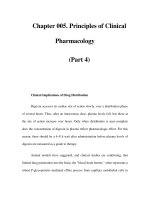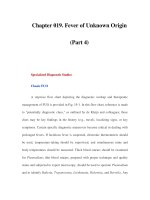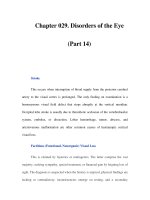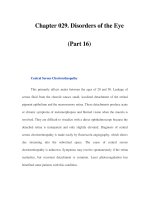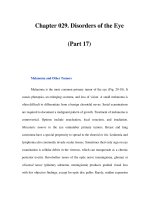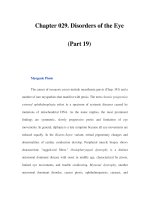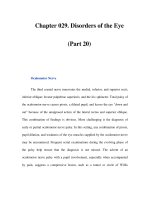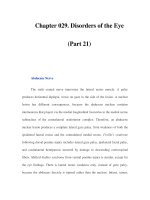Chapter 029. Disorders of the Eye (Part 4) potx
Bạn đang xem bản rút gọn của tài liệu. Xem và tải ngay bản đầy đủ của tài liệu tại đây (60.7 KB, 5 trang )
Chapter 029. Disorders of the Eye
(Part 4)
Stereopsis
Stereoacuity is determined by presenting targets with retinal disparity
separately to each eye using polarized images. The most popular office tests
measure a range of thresholds from 800–40 seconds of arc. Normal stereoacuity is
40 seconds of arc. If a patient achieves this level of stereoacuity, one is assured
that the eyes are aligned orthotropically and that vision is intact in each eye.
Random dot stereograms have no monocular depth cues and provide an excellent
screening test for strabismus and amblyopia in children.
Color Vision
The retina contains three classes of cones, with visual pigments of differing
peak spectral sensitivity: red (560 nm), green (530 nm), and blue (430 nm). The
red and green cone pigments are encoded on the X chromosome; the blue cone
pigment on chromosome 7. Mutations of the blue cone pigment are exceedingly
rare. Mutations of the red and green pigments cause congenital X-linked color
blindness in 8% of males.
Affected individuals are not truly color blind; rather, they differ from
normal subjects in how they perceive color and how they combine primary
monochromatic lights to match a given color.
Anomalous trichromats have three cone types, but a mutation in one cone
pigment (usually red or green) causes a shift in peak spectral sensitivity, altering
the proportion of primary colors required to achieve a color match. Dichromats
have only two cone types and will therefore accept a color match based upon only
two primary colors.
Anomalous trichromats and dichromats have 6/6 (20/20) visual acuity, but
their hue discrimination is impaired. Ishihara color plates can be used to detect
red-green color blindness.
The test plates contain a hidden number, visible only to subjects with color
confusion from red-green color blindness. Because color blindness is almost
exclusively X-linked, it is worth screening only male children.
The Ishihara plates are often used to detect acquired defects in color vision,
although they are intended as a screening test for congenital color blindness.
Acquired defects in color vision frequently result from disease of the macula or
optic nerve.
For example, patients with a history of optic neuritis often complain of
color desaturation long after their visual acuity has returned to normal. Color
blindness can also occur from bilateral strokes involving the ventral portion of the
occipital lobe (cerebral achromatopsia).
Such patients can perceive only shades of gray and may also have difficulty
recognizing faces (prosopagnosia). Infarcts of the dominant occipital lobe
sometimes give rise to color anomia. Affected patients can discriminate colors, but
they cannot name them.
Visual Fields
Vision can be impaired by damage to the visual system anywhere from the
eyes to the occipital lobes. One can localize the site of the lesion with considerable
accuracy by mapping the visual field deficit by finger confrontation and then
correlating it with the topographic anatomy of the visual pathway (Fig. 29-3).
Quantitative visual field mapping is performed by computer-driven
perimeters (Humphrey, Octopus) that present a target of variable intensity at fixed
positions in the visual field (Fig. 29-3A).
By generating an automated printout of light thresholds, these static
perimeters provide a sensitive means of detecting scotomas in the visual field.
They are exceedingly useful for serial assessment of visual function in chronic
diseases such as glaucoma or pseudotumor cerebri.
Figure 29-3
